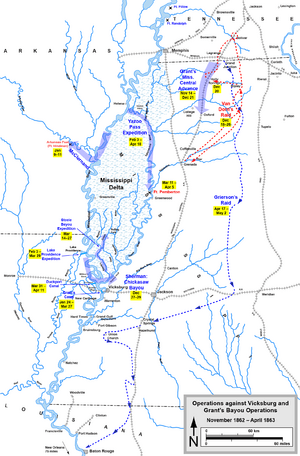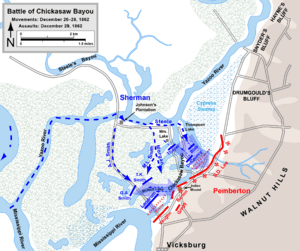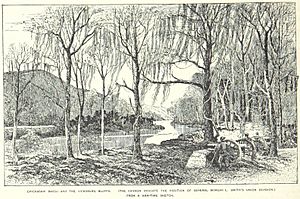Battle of Chickasaw Bayou facts for kids
Quick facts for kids Battle of Chickasaw Bayou |
|||||||
|---|---|---|---|---|---|---|---|
| Part of the American Civil War | |||||||
|
"Where Sherman failed" (from the Photographic History of The Civil War) |
|||||||
|
|||||||
| Belligerents | |||||||
| Commanders and leaders | |||||||
| William T. Sherman | John C. Pemberton Stephen D. Lee |
||||||
| Units involved | |||||||
| Army of the Tennessee Mississippi River Squadron |
Department of Mississippi and East Louisiana | ||||||
| Strength | |||||||
| 30,720 | 13,792 | ||||||
| Casualties and losses | |||||||
| 1,776 (208 killed, 1,005 wounded, 563 captured/missing) |
187 (57 killed, 120 wounded, 10 missing) |
||||||
The Battle of Chickasaw Bayou, also known as the Battle of Walnut Hills, took place from December 26 to 29, 1862. It was the first major fight of the Vicksburg Campaign during the American Civil War.
In this battle, Confederate forces led by John C. Pemberton stopped an attack by Union General William Tecumseh Sherman. Sherman's goal was to capture the important city of Vicksburg, Mississippi.
On December 26, Union soldiers landed near the Yazoo River. They tried to reach Vicksburg's defenses. Over the next few days, they pushed through swamps towards the strongly defended Walnut Hills. On December 29, Sherman ordered a direct attack. This attack failed, and the Union army suffered many losses. They had to retreat. This Confederate win, along with another victory at Holly Springs, stopped the Union's first attempts to capture Vicksburg.
Contents
Why the Battle Happened: Background
In November 1862, Union General Ulysses S. Grant began a plan to capture Vicksburg. Vicksburg was a very important city for the Confederates. It sat high on bluffs overlooking the Mississippi River.
Controlling Vicksburg meant controlling the entire Mississippi River. This was a key goal for the Union. Grant divided his large army into two parts. He led one part himself. The other part was led by General William Tecumseh Sherman.
Sherman's group, about 32,000 soldiers, traveled by boat down the Mississippi River. Grant's group marched south by land. The idea was for Sherman to attack Vicksburg from the river. Grant would try to draw Confederate troops away from the city.
On December 20, Sherman's boats left Memphis, Tennessee. They picked up more troops in Helena, Arkansas. By December 24, they were near Vicksburg. Sherman's soldiers landed at Johnson's Plantation, north of the city. Before they landed, the U.S. Navy cleared the river of underwater mines. During this, a Union ironclad ship, the USS Cairo, sank.
Who Fought: Opposing Forces
| Army Commanders at Chickasaw Bayou |
|---|
|
The Confederate forces defending Vicksburg were led by General John C. Pemberton. The direct commander of Vicksburg's defenses was General Martin L. Smith. General Stephen D. Lee was in charge of the main defense in the Walnut Hills.
Even though the Union army had more soldiers (30,720 vs. 13,792), the Confederates had strong defenses. The area was a difficult maze of nature and man-made obstacles. There were thick trees and swamps.
Chickasaw Bayou, a stream, was chest-deep and 50 yards wide. It was full of trees and ran parallel to the Union's path. This made it hard for Union soldiers to move and communicate. The Confederates also built strong barriers using felled trees. These were called abatis.
Union Army Leaders
Confederate Army Leaders
The Battle Begins
On December 26, Sherman sent out his troops to scout the Confederate defenses. They moved slowly through the tough land. They had small fights with Confederate soldiers. On December 28, a Union division tried to go around the Confederate right side. But Confederate cannons stopped them.
On the morning of December 29, Sherman ordered his cannons to fire on the Confederate lines. He hoped this would weaken them before a big attack. For almost four hours, cannons fired along the battle line. But they did little damage.
At 11 a.m., the cannon fire stopped. The Union soldiers got ready to attack. Sherman knew the Confederate defenses were strong. He said, "We will lose 5,000 men before we take Vicksburg, and may as well lose them here as anywhere else."
At noon, Union troops charged forward. They crossed water and barriers of felled trees. They managed to capture some forward rifle pits. But when they reached the main Confederate line, they faced heavy fire. The Union attack began to fall apart. The soldiers who survived fell back across the bayou.
Confederate General S.D. Lee ordered a counterattack. His men captured 332 Union soldiers and four battle flags.
Another attack was ordered by Sherman. Two Union divisions tried to cross Chickasaw Bayou. Their goal was to capture a spot called the Indian Mound. This mound was in the middle of the Confederate line. Union engineers built a road to help cross the bayou. But five attempts to take the Indian Mound failed.
On the far right side of the Union line, another attack was easily stopped by the Confederates.
What Happened Next: Aftermath
That evening, Sherman said he was "generally satisfied" with his men's spirit. But their attacks had failed against the strong Confederate positions. The battle was a clear victory for the Confederates.
The Union suffered many more losses. They had 208 killed, 1,005 wounded, and 563 captured or missing. The Confederates had much lighter losses: 57 killed, 120 wounded, and 10 missing.
Sherman talked with Admiral Porter, whose navy ships had also failed to damage the enemy. They decided to try attacking again the next day. But by December 30, Sherman realized that attacking the same spot again would not work.
He and Porter planned a new attack on Drumgould's Bluff. This was to the northeast. They hoped the steep bluffs would hide their soldiers as they advanced. This move had to be a secret. But the attack was called off due to heavy fog on January 1, 1863.
At the same time, General Grant's overland attack was also failing. Confederate raids destroyed his supply lines. Without supplies, Grant had to stop his advance. Sherman realized that Grant's troops would not reinforce him. So, he decided to pull his forces out. They moved to the mouth of the Yazoo River on January 2.
On January 5, Sherman wrote a letter saying, "I reached Vicksburg at the time appointed, landed, assaulted, and failed." He and his troops were then sent on another mission. The main Vicksburg Campaign did not start again until April 1863.
Images for kids








